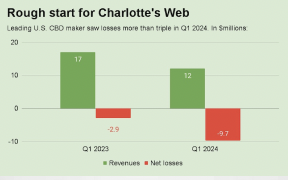I’m currently working on a longer post on the impact of Chevron’s demise and its impact on drug policy. I’m sure On Drugs alum and admin law pro Shane Pennnington will have a lot to say in the coming weeks as well. In the meantime, I want to publish a short note expanding on my quick take on X: A Chevron PrimerDepending on who you read, Chevron’s demise is either the first step toward the Republic’s downfall or restoration. Let’s start with the basics. Chevron deference or the Chevron doctrine is a legal framework that courts used to review agency interpretations of ambiguous statutes. Succinctly stated, under the doctrine, courts reviewed an agency’s interpretations of a statute by asking two questions:
These two components of the framework came to be known as “Chevron Step One” and “Chevron Step Two.” If the answer at both steps was “yes,” then a reviewing court would defer to the agency’s interpretation even if that interpretation was not the best interpretation of the statute. Over time, the Supreme Court added layers and nuance to the framework. For example, in United States v. Mead, the Court added a “Step Zero” threshold level question where a reviewing court asks whether the two-step Chevron analysis even applies. Exceptions to Chevron proliferated. For example, under the “major questions” doctrine, the Supreme Court refused to defer to agency interpretations on questions having vast “economic and political significance” where Congress did not clearly empowered the agency with authority over the issue. Whatever that means. The Chevron doctrine rested on a number of fictions, most prominently, “implicit delegation”: the notion that when Congress leaves ambiguities or gaps in a statute an agency administers, Congress implicitly delegated authority to the agency. Pragmatism also supported Chevron—or at least it did as originally conceived. Rather than have generalist federal judges without special subject matter expertise pass on statutory interpretation questions, why not give the experts (i.e., bureaucrats in federal agencies) the benefit of the doubt? Perhaps I’ll dive more in depth in my next post related to Chevron and drug policy more generally. Suffice to say, Chevron gave agencies a tremendous handicap when it came to applying statutes. After all, after enough time, with evolving society and technology, all statutes are bound to give rise to gaps and ambiguities. A statute can only be so precise and prescient Chevron tilted the scales of justice with these necessities and eventualities in favor of the agency. But as the Loper Bright opinion makes clear, decades after Chevron, the framework became unworkable: Exceptions became too many. Courts couldn’t agree when a statute was ambiguous. The nature of the doctrine and a (terrible) case called Brand X allowed different administrations to adopt different meanings of a statute—even when a prior judicial precedent held an ambiguous statute meant otherwise. The Supreme Court reviews many agency interpretations every term, but had not deferred under Chevron since 2016. Why Overturning Chevron Was a Good Thing for ReschedulingIn the above quick take on X, I’m not stating that overturning Chevron is bad for rescheduling. Hardly. What I’m saying is that overturning Chevron was good for rescheduling. Now, not so clear what impact Chevron has. Rather, before these rescheduling proceedings, overruling Chevron was a clear boon. That is because DEA refused to entertain petitions to reschedule marijuana—for example, in 2016—by relying on a five-part test that most certainly did not constitute the best reading of the statute, specifically the phrase “currently accepted medical use in treatment in the United States.” And, it is precisely that interpretation of the statute—and the erroneous application of Chevron deference—that prevented earlier rescheduling efforts from succeeding. DEA first construed the statutory phrase in a case called Grinspoon v. DEA related to MDMA scheduling. In that case, among other items, Lester Grinspoon (backed by Rick Doblin / MAPS predecessor) challenged DEA’s interpretation of the phrases “currently accepted medical use in treatment in the United States” and “accepted safety for use . . . under medical supervision” in the Controlled Substances Act. DEA contended that MDMA belongs in Schedule I, while Grinspoon et al. argued it belonged in Schedule III. DEA’s position rested on its understanding of the two statutory phrases. DEA contended that both phrases meant that the FDA has evaluated the drug and approved it for interstate marketing, i.e., FDA-approval. Grinspoon et al. argued that DEA misinterpreted the statute and that the two phrases should be interpreted with reference to the medical community. At the outset of the case, the appeals court reviewed DEA’s interpretation under Chevron. But while the appeals court concluded that the statute was ambiguous, it did not adopt DEA’s construction because the court found it to be reasonable. Nonetheless, Grinspoon laid the groundwork for deference to DEA’s interpretation of “currently accepted medical use” in future rescheduling proceedings related to cannabis. And that’s what happened years later, when the D.C. Circuit reviewed DEA’s decision to keep marijuana in Schedule I in the 1991 case Alliance for Cannabis Therapeutics v. DEA. The case essentially begins and ends with Chevron. An administrative law judge (ALJ) in 1988 concluded that the evidence supported rescheduling marijuana from Schedule I because it had a “currently accepted medical use.” DEA superseded that recommendation, however, by interpreting “currently accepted medical use” to require eight factors:
Although, as the ALJ found, evidence showed the usefulness of cannabis with patients undergoing chemotherapy, applying the eight factors, DEA concluded that the evidence did not establish a “currently accepted medical use.” On appeal, the D.C. Circuit explained as follows:
To summarize, after an evidentiary hearing an ALJ concluded cannabis had an accepted medical use based on evidence from the medical community. DEA then changed its interpretation of the law. Under a different standard, that same evidence did not establish medical use. Only FDA approval would meet the mark. The reviewing appeals court then deferred to DEA’s interpretation of the statute under Chevron and was essentially obliged to accept the agency’s findings about the evidence under the APA. The 1991 ACT court did go on reject three of the test’s factors because those conditions were impossible to meet and sent the case back down to the agency for an explanation. On remand, however, the agency simply changed the test again resulting in the “five-part test.” This time, as the recent Office of Legal Counsel memo explains the reviewing court rejected the claim that DEA’s order “rested on an ‘unreasonable interpretation of the statute’”: In other words, the DEA’s order rejecting rescheduling rested on an interpretation of “currently accepted medical use” that passed muster under Chevron, even if that interpretation was not the best interpretation of the statutory phrase. As Shane and I argued here and elsewhere, extensively, the decision to afford DEA Chevron deference in this regard was error for a variety of reasons. One of those reasons is an important one: the CSA delegates responsibility over medical/scientific matters to HHS, as the Supreme Court held in Gonzales v. Oregon. It is impossible to square Chevron deference to DEA to interpret “currently accepted medical use” in light of that delegation to HHS and the holding in Gonzales. We made that argument in the highlighted citation above from the case we litigated, Sisley v. DEA. In view of those petitioners’ arguments, Judge Watford’s concurrence states:
So Why Overturning Chevron Is A Nothingburger For Rescheduling Going Forward?Put simply, Chevron stitched together DEA’s five-part test that resulted in the denial of all rescheduling petitions. But it doesn’t stitch together the current HHS test endorsed by OLC. The starting point for understanding why Chevron’s demise isn’t some watershed event for rescheduling starts with the decision overturning Chevron itself—Loper Bright—and some fundamental points about Chevron. First, what Chevron never did and its overruling does not do: Chevron never affected the standard of review courts applied to review agency determinations and findings of fact. Chevron required courts to defer to agency interpretations of ambiguous statutes. But under the APA, courts have always had to effectively defer to factual findings of agencies under the highly deferential “arbitrary and capricious” standard: Second, consider the Loper Bright opinion that overruled Chevron. Loper Bright says that § 706 shown above, in which the “reviewing court shall decide all relevant questions of law,” incorporates the “traditional understanding of the judicial function,” i.e., that courts say what the law is, not executive agencies. But a statute may expressly give an agency discretion as to a particular matter or empower an agency to fill the details of a statutory scheme. Per the Supreme Court, “[w]hen the best reading of a statute is that it delegates discretionary authority to an agency, the role of the reviewing court under the APA is, as always, to independently interpret the statute and effectuate the will of Congress subject to constitutional limits.”¹ As it happens, the CSA isn’t “silent” on delegating and doesn’t rely on a Chevron fiction of implied delegation. Rather, as the Supreme Court stated in Gonzales v. Oregon, where the Supreme Court held that the Attorney General, via a rule interpreting the Controlled Substances Act, could not bar doctors from prescribing a drug to be used in aid-in-dying:
The recent April 2024 memo from the Office of Legal Counsel (OLC)—the “secretive” office within the Department of Justice that “can sway the whole government”—offers a similar take and elaborates. The executive branch interprets these OLC memos to be binding interpretations of law. And, just as we argued in Sisley, the OLC memo concurs in concluding that DEA’s five-part test construction of “currently accepted medical use in treatment in the United States” is an “impermissibly narrow” construction of the statutory language based on the plain meaning of the text:
Rather than use DEA’s five-part test to conclude that marijuana had a “currently accepted medical use,” HHS used a two-part inquiry:
Next, OLC concludes that this new HHS’s two-part inquiry was “sufficient” to determine whether a drug has a CAMU. Notably, the HHS currently accepted medical use finding is a determination based on scientific and medical evidence:
Finally, OLC explained in the memo that under the express delegations in the CSA, DEA had to give significant deference to HHS’s scientific and medical determinations—which should include whether a drug or substance has a “currently accepted medical use”:
ConclusionSo where does that leave us? All in all, Chevron’s demise was an unquestionably positive sign for rescheduling back when DEA used its five-part test to reject rescheduling petitions. That is because DEA used Chevron to stich the five-part test together. Notably, HHS used that test as well as recently as in the July 2016 petition denial process. Now, however, HHS used a new test. That test follows from the plain meaning of the statutory text. HHS applied that test according to s delegation in the CSA that has it making findings/determinations on medical and scientific matters. That express delegation likely still gets some dap even after Loper Bright as well as the OLC memo that binds DEA going forward. And, of course, deference to agency factual findings under the APA remains undisturbed. This is not to say that Chevron’s demise won’t impact rescheduling at all or in other spheres DEA or FDA regulate. Quite the contrary. More on that in the next essay. I’m sure Shane—an admin law/cannabis law pro—will have a lot more to say about the above as well, wherever it is he writes these days. But suffice to say, as far as I can tell, this take that Schedule will be “canceled” … …isn’t a fully baked and ought not to be give much deference. 1
The Loper Bright opinion leaves Skidmore undisturbed, where courts may seek aid from interpretations of those responsible for implementing particular statutes: “[I]n an agency case in particular, the reviewing court will go about its task with the agency’s ‘body of experience and informed judgment,’ among other information, at its disposal” |

























